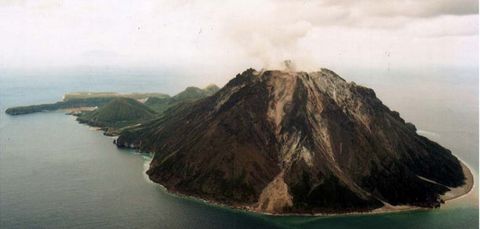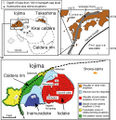Introduction to Satsuma-iojima
火山研究解説集:薩摩硫黄島 (産総研・地質調査総合センター作成)
| Contents: Satsuma-iojima |
|---|
|
What is Satsuma-iojima?
Satsuma-iojima (hereafter mostly abbreviated to ‘Iojima’ within the homepage) is a volcanic island situated about 50 km to the south of Satsuma Peninsula, the southernmost promontory of Kyushu (Fig. Locations of Satsuma-iojima and Kikai Caldera). It forms a part of rim of a huge Kikai Caldera along with Takeshima situated next to Satsuma-iojima (Topo map of Kikai Caldera).
Most volcanoes of Japan are aligned along the volcanic front and Satsuma-iojima Volcano (Kikai Caldera) is no exception situated along the volcanic front with other volcanoes of Kyushu such as Kuju, Aso, Kirishima, Sakurajima, and Kaimondake from north to south. Satsuma-iojima Volcano is at the northern end of Nansei Islands which are on the front. The front continues further to the south as a line of active volcanic islands, Kuchinoerabujima, Nakajima, and Suwanosejima.
Iojima, together with Takeshima and Kuroshima, administratively belongs to Mishima, Kagoshima Prefecture. Population is 114 (September 1, 2009) (Based on the data of the homepage of Mishima). The island is served by a village-run ferry every other day between the ports of Kagoshima and Takeshima, Iojima, and Kuroshima. The voyage takes about 3 and half hours.
There are five accommodations in the island (as at 2007).
Volcano, hot springs, and historical sites
The island is regarded as Kikaigashima, to which the Buddhist monk, Reverend Shunkan, was banished, described in the well-known Story of Heike. Iojima is, therefore, an island of legend. On the other hand, at Iodake occupying the eastern half of the island, a column of smoke has never ceased to rise, and hot springs are distributed everywhere within the island (See Volcanic gases and hot springs section). There is a hot spring where open-air bathing can be enjoyed on the beach. Therefore, the island can be characterized as an island of volcano and hot springs too.
Free-running peacocks are seen in this idyllic island of the south sea, but according to the ranking of volcanic activities by the Meteorological Agency, the volcano is designated as one of the 13 A-rank volcanoes for its activity (Refer to the ranking of volcanoes in Japan in the homepage of the Meteorological Agency). According to the latest study, an explosive eruption occurred about 500 to 600 years ago at Iodake (See Recent eruptions section of this version)
At the beginning of Showa period (1920s to 1930s) there was a submarine explosion that formed Showa-iojima about 2 km offshore in ENE of Iojima. The explosion was the largest explosion in Japan in the Showa period. Emission of volcanic gases is rigorous amounting to the same rank to Miyakejima, Sakurajima, and Asama volcanoes (See Recent eruptions section of this version). Continuous smoke columns rising from the summit where bare rocks are exposed remind us the fact that this is really an active volcano.
Mining of sulfur and silica stone at Iodake
At the summit of Iodake sulfur was used to be mined in the old days while in recent years silica stone was mined. Even in the Story of Heike mining operation of sulfur was mentioned.
Sulfur was derived from volcanic gas as sublimation deposit, and the silica stone is an alteration product from preexisting rocks with reactions of strongly acidic hot water condensed from the gas. Those ores, therefore, can be regarded as a gift from the volcano.
Road was constructed for sulfur mining, and stonewall-lined tracks were maintained within the summit crater. The figure on the right is a map of the summit area prepared in 1960s showing tracks on the steep inner wall of the crater edge. Sulfur refinery was built at the summit and at some time a cableway carried sulfur from Iodake to Nagahama via Inamuradake.
Mining of sulfur at the summit became un-economic in middle Showa period, but mining of silica stone commenced instead (The figure on the left). Heavy machineries were employed for silica stone mining operation, but this too was halted in 1997.
Characteristic features of Satsuma-iojima Volcano
Volcanologically this is an interesting place as studies within the crater including collection of high temperature (800 to 900℃) gas is possible despite Iojima’s status as an active volcano. In general, studies within the crater are too hazardous because of the danger from eruptions, too steep a topography, brittle nature of rocks, etc. As high temperature volcanic gas does not change its compositions during migration from the magma to the ground surface, analysis of the gas would give important information as to the nature of the magma. Only a few volcanoes in the world other than Iojima, e.g., Kudriavy Volcano in Etorofu Island (Kuril’skiye Ostrova), Kuril Islands, allow direct collection of such hot volcanic gas.
Although it is possible to enter into the crater, the area is full of acid gas at high temperature and no sightseers are allowed. The picture shown above (observation of high temperature volcanic gases) is a scene of direct collection of volcanic gas, and the person collecting the gas wears protective face mask and a pair of goggles which are essential for protection of throat and eyes. Near the high temperature fumaroles the underground temperature at several tens of cm deep reaches several 100℃ (See Heat discharge section), and heat resistant gloves have to be added as inner soles even wearing thick-soled mountaineering boots.
Despite the fact that inside of the crater is a place of dirty, hard, and hazardous environment for volcano researchers, detailed observations and studies are indispensable in providing essential information on the origin of volcanic gases, relationship between the gases and hot springs at the foot of the mountain (See Volcanic gases and hot springs section), the mode of discharge of volcanic gases from the magma, and the location and volume of the magma (See Magma system section).
In this summary version of the volcano studies, the growth history of Satsuma-iojima Volcano (See History of the volcano section), internal structure of the volcano (See Underground structure section), and volcanic activities are described for laymen fully utilizing photos and diagrams. Some of the photos are taken at hard-to-visit places such as inside of the crater and seafloor, and one can have simulated experiences how volcanologists work. We hope the readers are interested in volcanoes and volcanology. We suggest reading of the full version (in Japanese) for further information.
(Yoshihisa KAWANABE・Genji SAITO・Hiroshi SHINOHARA)














